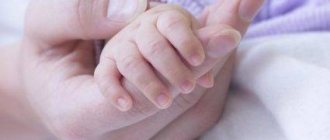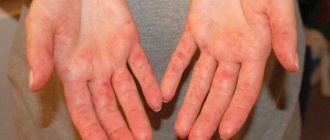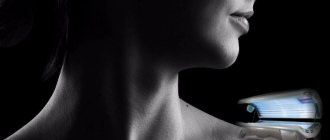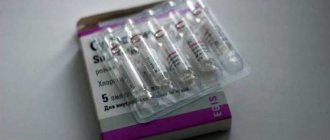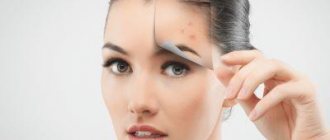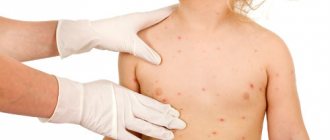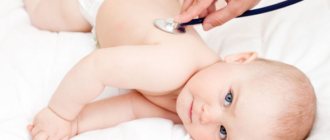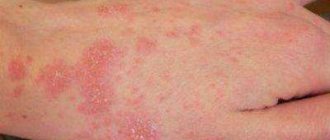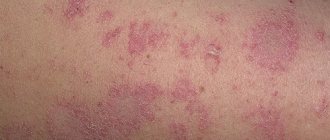Rashes on children's palms: causes, symptoms, how to get rid of the disease
A rash on the palms of a child should be a cause for concern for the mother. There are many reasons that cause its appearance. To find out the nature, you will need to consult a pediatrician.
Various circumstances can provoke skin sores.
Factors that provoke rashes
The appearance of a rash on the palms of a child that itches can be caused by various factors. In infants, similar symptoms appear due to allergies, especially during the period of introducing complementary foods. Sometimes sores, bubbles and blisters signal serious pathologies.
Allergic reaction
The formation of hives on the palms indicates that the baby has been in contact with an allergen or has eaten a prohibited product.
Various foods and substances can cause allergies:
- sweets;
- dairy products;
- animal hair;
- medications;
- dust;
- washing powder or conditioners.
On a note. Allergy is manifested not only by a bright red rash on the palms. Additionally, there is itching, runny nose, sneezing and other allergic symptoms.
Contact dermatitis
This is another type of allergic reaction, since contact dermatitis is triggered by contact with an allergen. The rash appears in the form of red formations. Bubbles and blisters may occur. The skin constantly itches, pimples burst, forming wounds and cracks.
In addition to the allergen, contact dermatitis is caused by problems with the digestive and circulatory systems, and various infections.
Skin infection by parasites
Parasites and insects often provoke the appearance of rashes on the hands. Small palms may develop an allergic rash from the bites of wasps, bees, and mosquitoes.
A mite can cause severe itching and the appearance of a rash; it settles on the palms, in the folds of the skin, and on the genitals. The disease is called scabies.
On a note. Do not confuse the rash with numerous mosquito bites, fleas and jellyfish stings. Insect marks may swell and the child will scratch them.
Viral infection
Rashes are a sign of developing infections. Along with the rash, symptoms characteristic of acute respiratory infections appear. The most common infectious diseases:
- Chickenpox. Small spots form, which gradually transform into bubbles no larger than 5 mm in size. After a week, the pimples will disappear, leaving thin crusts.
- Measles. Additionally, there are signs of infection (fever, cough, lethargy). The first sores appear on the head, then move to the palms, feet, and torso.
- Coxsackie virus. A special type of infection, one of the symptoms of which is a rash.
- Rubella. The first rashes form on the outer side of the palm, the folds of the arms and legs. The sores are thick and small. Accompanied by signs of intoxication.
- Scarlet fever. First, the throat begins to hurt, like a sore throat, and on the 2nd day small rashes appear.
A common cause of rash is rubella
It is impossible to manage infections without medical care, since incorrect diagnosis and treatment can provoke the development of complications.
Overheating, which causes sweating
A simple lack of hygiene can cause skin rashes. If you do not wash your baby in a timely and regular manner, sweat rash initially appears. If the baby scratches the sores, infections and bacteria can get inside, which can cause the formation of pustules.
For your information. Excessive wrapping of the baby can often trigger the formation of heat rash.
Psoriasis and eczema
Eczema is a pathology of a neuro-allergic nature. Initially, small blisters may appear that itch. Gradually they fill with pus. Typically, eczema is accompanied by the development of a bacterial infection.
Gradually, with eczema, instead of rashes, large areas of peeling appear
The development of psoriasis can cause rashes. The pathology, which is characterized by damage to the dermis and is chronic, is not infectious in nature. A small rash on the child's palms and soles is very itchy. As a result of scratching, plaques form.
Other causes of rash
Often the cause of rashes is problems with the functioning of some internal systems of the body. If the circulatory system malfunctions, hemorrhagic rashes may appear on the arms, hands, and feet. The reason is the destruction of blood vessels and capillaries. Red blood cells leak through the skin, causing dark spots to appear on the surface of the epidermis.
On a note. This rash on the child’s palms and other parts of the body does not cause discomfort, but it signals possible pathologies.
Types of rashes
Rash on a child's chin - causes of red pimples
The appearance of a rash on the palms does not go unnoticed by parents. The rashes may differ from each other in appearance:
- Reddish blisters. Most often, a colorless liquid collects under the top layer of the epidermis.
- Pimples. These are nodules hidden in the skin.
- Pustules. Inside are filled with purulent fluid.
- Blisters. They rise above the skin level, are rough on top and dense in structure.
- Ulcers and erosions. Damage to the skin, which is characterized by various discharges.
- Stains. Accumulations at the skin level that differ in color from it.
If crusts begin to form at the site of the rash, this is a signal of gradual recovery.
What to do with a child's rash
Any rash on the palms, feet, elbows, and fingertips is a signal for parents. Consultation with a pediatrician will help. Only an experienced specialist will correctly diagnose the cause of the problem and prescribe appropriate treatment.
It is not necessary to see a doctor if the mother understands for sure that the rash is a heat rash or a known allergy.
Important points before the pediatrician arrives
If a rash appears in a child, other possible symptoms should be diagnosed and reported to the doctor.
Possible additional signs of disease:
- temperature;
- runny nose;
- nausea and vomiting;
- cough;
- pain;
- lethargy;
- loss of appetite.
If a rash appears on the palms of your hands, you should check your baby's entire body and mouth, especially the feet and legs. Until the cause is determined, a child with a rash is isolated from others.
Need for medical attention
Call an ambulance if a child has a red rash on the palms of their hands accompanied by other symptoms:
- high temperature;
- vomiting or nausea;
- severe itching;
- lethargy and loss of appetite.
If there are no severe accompanying symptoms, but the causes and nature of the rash are not clear, then a trip to the pediatrician is required.
Diagnosis and treatment
If a rash appears on the palms, feet and other associated symptoms, only a medical institution will carry out a high-quality diagnosis. Through a series of tests, the true cause of the problem can be identified.
The first diagnostic step is to examine the body for other rashes.
Initially, the baby will be examined by a doctor. General blood and urine tests are prescribed. If necessary, the child is referred to a dermatologist, who will write out directions for specific tests.
Prevention
The likelihood of a rash appearing in a child under one year old can be minimized by taking simple preventive measures:
- Proper balanced diet, which should be free of allergens.
- Be sure to stick to your daily routine.
- From the first days of life, you need to teach your child to wash himself, wash his hands after going outside, and before eating.
- All family members, including a newborn, should have their own personal hygiene items.
- Contact with unfamiliar animals is not allowed.
- In cold weather, the use of mittens is mandatory.
Prevention is the best way to deal with possible problems
Most often, the cause of a rash on the feet and palms of a child is an allergy, but other factors should not be excluded. Avoiding problems is much easier than treating them later.
If the rash is caused by a disease, and its appearance is accompanied by other symptoms (fever, runny nose, disruption of the digestive system), then you should not hesitate.
In this case, you cannot do without medical help.
Source: https://kpoxa.info/zdorovie-pitanie/syp-na-ladonyakh-rebenka.html
Physiotherapeutic procedures
They are carried out after the patient takes medication. They also show good results between exacerbations. These activities calm the central nervous system, normalize the activity of the endocrine system, reduce burning and itching, as well as pain. Which methods are most widespread:
- cryotherapy. problem areas are treated with liquid nitrogen;
- irradiation of blood with ultraviolet light;
- acupuncture;
- ozone therapy;
- bioresonance therapy;
- ultraphonophoresis;
- paraffin applications;
- Electrosleep is a procedure that helps stabilize the patient’s psychological and physical condition.
Baths also have a good effect. For dry eczema, radon is recommended, and sulfide is recommended to relieve pain and swelling. Baths using medicinal herbs are indicated for any type of disease. Tar helps improve blood circulation in the affected areas. Other physiotherapy techniques with proven effectiveness:
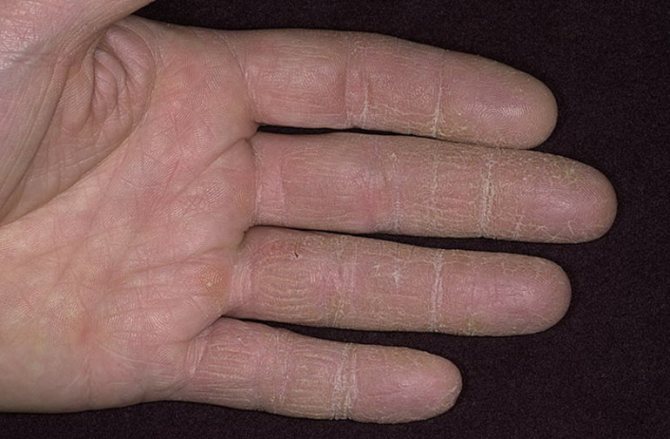
- magnetic therapy - reduces the severity of inflammation;
- darsonval;
- thalassotherapy;
- inductothermy is a good method for eliminating malfunctions of the endocrine system;
- electrostatic shower;
- use of therapeutic mud;
- laser therapy - indicated at the final stage of treatment, it fights rough scars on the epidermis.
Many of these procedures trigger the production of glucocorticosteroids in the body. These compounds reduce the severity of the autoimmune response and promote recovery in dermal cells. By combining several techniques, you can improve the final result. You can also resort to combinations with medications. An example is the combination of electrophoresis with the use of dimexide. In this case, it is possible to achieve faster healing of the epidermal structure.
Rash on the palms and soles of a child in the form of pimples, blisters or spots, photo with explanations
Rash! It would seem that why doesn’t she appear! However, each case requires attention, because if you do not take timely measures, you can miss a serious illness.
It is especially unpleasant when it is found on the palms and soles of a child. He may experience discomfort when walking, and contagious diseases that cause the rash can be passed on to healthy children. Why does she appear? How to find out whether it is dangerous or not?
Rash in all its diversity
Pimples and redness on the skin are always unpleasant, especially on the hands. They make others fear infection; parents of other children forbid them to play with a sick child. Of course, the reason for the appearance may be completely harmless, but no one wants to take risks.
There are many types of rashes:
- watery blisters occur in some viral diseases; when they open, they can serve as an entry point for infection;
- blockage of the sebaceous glands looks like white or black dots on the skin;
- inflammatory processes in the sebaceous glands lead to the formation of subcutaneous papules;
- purulent blisters are painful and greatly disturb the child;
- dry pimples may be crusty;
- spots with scales and blisters often also itch;
- The red rash is caused by both harmless causes and a number of infectious diseases.
What can cause rashes on the hands and feet of children?
There are several reasons for the appearance of a rash on the palms and soles of a child. The most harmless is prickly heat caused by overheating. It may go away on its own, but small red pimples can easily be confused with a rash of another origin. No matter why a rash appears on a child’s palms, you need to show it to a doctor (we recommend reading: rash on the back after a fever in a child: causes, methods of treatment).
You should not delay seeking medical help. Some diseases manifest themselves as rashes for a short period of time, and when the pimples go away, it will be more difficult to make a diagnosis. Other types of rashes may develop, causing further deterioration of the skin.
Inflammatory processes in the arms and legs will prevent a child from playing normally, and a schoolchild from studying. To save a child from discomfort, it is necessary to promptly identify the pathogen and begin treatment.
Fungal infection
Pathogenic fungi are present on the skin of any person. However, they begin to manifest themselves when immunity decreases. Fungal diseases can also be caused by stress, insufficient and unbalanced nutrition, and long-term use of antibiotics. The fungus can also develop against the background of hormonal imbalance or intestinal diseases.
The fungal disease is accompanied by the appearance of an allergic rash consisting of pustules. A pustule is a round pimple that contains pus inside. Later, crusts form in place of the pustules.
The rash may cause a burning sensation and itching. Localization may vary, but most often the feet and palms are affected.
Treating fungus is long and difficult. The disease is chronic and relapsing. However, it is necessary to treat persistently, since the fungus can spread throughout the body, leading to damage to the scalp and alopecia.
The disease is especially severe in those suffering from diabetes, asthma, and vascular diseases.
To avoid complications and secondary infection with other pathogens, you need to contact a dermatologist and follow all his instructions.
Insects and parasites
An example of the cause of such rashes is worms. They are found inside the body, most often in the intestinal lumen, but the body's reaction to them often leads to the appearance of a rash. Rash caused by worms comes in different types:
- small red pimples, like hives;
- affected areas that look like eczema;
- acne or boils;
- neoplasms on the skin such as papillomas and papules.
The resulting rashes are itchy, their appearance depends on the type of parasites that have settled in the body. Treatment of itchy spots will only give results if it is combined with anthelmintic therapy.
A rash occurs on the palms and when infected with scabies (pictured). The scabies mite that causes the disease settles in the upper layer of the skin. Infection occurs through contact with a sick person or an object that he touched. The pimples caused by scabies are very itchy, do not give the child any rest, the itching intensifies at night (more details in the article: scabies in a child: symptoms with photos and methods of treatment).
If you have the slightest suspicion of scabies, you should consult a doctor, as it can spread throughout the body and is highly contagious. The patient must be isolated and provided with separate towels and bed linen.
Insect bites usually result in redness, swelling, or a blister at the site of the skin break. They may be accompanied by severe itching or even severe pain. A rash that looks like hives appears if a child is allergic to insect venom. The rash may appear as multiple bites from fleas, lice or ants.
Skin diseases of other nature
Flat papules, merging into large solid spots covered with silvery scales, appear on the skin with psoriasis. The formation of papules is accompanied by severe itching. The disease is autoimmune in nature and is not dangerous for others. However, it is impossible to recover from it; you can only stop the development of the disease and stop relapses.
Eczema on the hands is also not contagious. It is believed to be allergic in nature, but the exact origin of the disease is unknown. At risk are children who have this disease in their family. Small pimples appear on the skin, their formation is accompanied by redness, swelling and severe itching.
Medicine knows a considerable number of diseases, the manifestation of which is a rash. Rashes often signal diseases of the internal organs:
- Lesions of the gastrointestinal tract can cause pyoderma gangrenosum, in which spots similar to insect bites appear on the legs, but later, if left untreated, the spots turn into ulcers with purple edges.
- Liver diseases at the initial stage make themselves known by characteristic skin rashes. The content of bile acid in the blood increases, which leads to general poisoning. When the bile ducts are blocked, a rash forms on the palms and soles of the feet. Externally, the spots resemble burn marks. The rash can be combined with spider veins; they are very itchy, especially at night.
- Nervous eczema may appear on the hands. It indicates a malfunction in the nervous system. The causes of rashes can be nervous tension and stress. The rash is similar in appearance to urticaria and is very itchy (we recommend reading: what urticaria looks like in children and photos of the initial stage).
- In diseases of the blood or blood vessels, damage to the walls of the capillaries leads to the appearance of small spots of bright red color - petechiae. It helps to recognize their origin that the rash does not change color when pressed. The rash covers the entire body. In children, especially newborns, rashes are possible due to Werlhof's disease - blocking of capillaries and small arteries with blood clots. Petechiae occur at injection sites and are painless. The rash may indicate hemoblastosis or be a consequence of diabetes mellitus. In diabetes mellitus, it indicates a change in blood sugar levels and appears on any part of the body, including the feet.
In what cases is it necessary to consult a doctor?
The appearance of changes on the skin that are not caused by known external causes always signals some kind of disease. Often other symptoms appear along with pimples or spots, which suggests a particular disease. You can treat the rash yourself only if its origin is precisely known. In other cases, you should immediately consult a doctor.
Using brilliant green to combat itching will change the color of the spots; ointments can distort the picture. For treatment to be successful, it is necessary to help the doctor make the correct diagnosis. You should not postpone visiting a specialist, since the manifestations of the disease may go away, but the disease itself will remain, and it will be more difficult to diagnose it.
https://www.youtube.com/watch?v=Ja5KDAwJ_3s
When a rash appears, depending on the accompanying circumstances, they consult different doctors:
- after taking medications, contact with household chemicals, introducing a new product, or the presence of strong odors, consult an allergist;
- if skin manifestations are combined with high fever and poor health, contact an infectious disease specialist;
- in case of intensification of manifestations, the formation of blisters, the appearance of a burning sensation, tingling, bleeding - contact a dermatologist;
- the spread of redness after a tick bite, even if considerable time has passed since the bite, is a reason to immediately visit an infectious disease specialist (we recommend reading: what mosquito bites look like in children: ways to relieve itching and swelling with photos).
READ ALSO: tick bite in a child: symptoms, consequences, treatment methods
Early seeking medical help will help you quickly take action even in the event of a dangerous illness. You should not risk your child’s health by using home methods to combat skin pathologies.
Source: https://www.deti34.ru/simptomy/kozha/syp-na-ladoshkah-u-rebenka.html
Symptoms of eczema
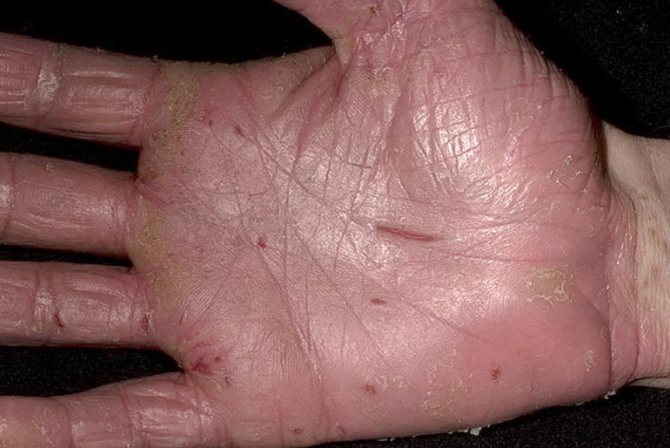
Eczema on the hands causes and treatment are closely related to each other. Therapy is selected individually for the patient each time. At first, the disease manifests itself through areas of redness on the hands that itch. Next, vesicles and bubbles with liquid appear. They are formed regardless of whether a person combed these formations or not. The epidermis becomes warm to the touch. Subsequently, the spread of these defects is observed, which transform into cracks and wet areas.
A person complains of a burning sensation in these areas. As soon as the vesicles burst, serous layers form on top, covered with a crust at the tips. Then they subside, and in their place you can find pale pink skin. A cosmetic defect that remains after an illness can remain for a long time, sometimes for life.
Rash on the palms of a child: causes, treatment, recommendations
Having discovered a rash on the palms of a child, caring parents usually immediately begin to sound the alarm. Rashes are often caused by diseases, often of an infectious nature, threatening the health and even the life of the baby.
Sometimes they are quite harmless and go away on their own. In any case, the child’s body signals about violations occurring inside. It is the responsibility of parents and doctors to understand what a rash is and why it appears.
Types of rashes
The rash in children, located on the inside or outside of the palms and noticeable to the naked eye, differs in color, severity, structure and arrangement of elements:
- bubbles - small or large swellings of the skin, filled with clear liquid inside;
- pustules - similar to vesicles, but contain pus inside;
- papules - nodular elements in the thickness of the skin;
- spots - accumulations of small elements located on the same level with the general surface of the skin;
- blisters are dense, rough elements that rise above the general level of the skin;
- erosions, ulcers – violations of the integrity of the skin in depth, accompanied by discharge.
Important points before the doctor arrives
If any of the above types of rash are detected on the palms of the hands, parents should record other possible symptoms:
- increase in general body temperature;
- the appearance of clear nasal discharge;
- coughing;
- nausea;
- pain in the stomach or throat;
- urge to vomit;
- lethargy;
- reluctance to eat.
You should also note the possible presence of a rash on the child's feet, legs, or mouth. If nothing is observed, it is necessary to remember and write down what food the child previously ate, what objects he played with and held in his palms. It is important to promptly note the child’s contact with a sick person and the possibility of infection.
All additional symptoms and knowledge will help make a quick and correct diagnosis.
Causes of the rash
In most cases, the factors leading to rashes are:
- Infectious diseases - accompanied by signs characteristic of acute respiratory infections, occurring along with a rash or after a few days. The most common diseases with a rash on the palms of the palms:
- chickenpox (smallpox) – spots that appear at first quickly turn into blisters up to 5 mm in size, the rash usually itches; located on the palms, face, head, torso, in the mouth;
- rubella - many small spots localized mainly in the folds of the arms and legs, on the outer side of the palms, they are accompanied by signs of intoxication;
- measles - a rash appears after a rise in temperature and other signs of infection, starting from the head, then moving to the torso, palms, arms, legs; the spots are red, large, merging;
- scarlet fever - rashes in the form of small dots appear after the appearance of signs of sore throat on the second day; especially abundant in skin folds, folds, on the outside and between the fingers;
- Allergic reaction. Hives on the palms of a child appear after he has directly touched the allergen or ingested it. Substances that cause allergies: dairy products, sweets, medications, animal hair, dust, cream, powder, etc. The rash is bright red, raised, itchy; detected with a runny nose, sneezing and other manifestations of allergies.
- Diseases from insect bites, parasites. Classic examples would be bites from mosquitoes, bees, and wasps, to which the child is allergic. The most common parasite that causes a rash that itches and appears between the fingers, palms, and genitals is the mite. The disease is contagious and is called scabies. Multiple mosquito bites, flea bites, or jellyfish stings should be distinguished from a rash.
- Diseases of the circulatory system. The rash is quite characteristic, hemorrhagic, and occurs due to the destruction of small vessels and effusions into the skin. It looks like a bruise or small rash in the form of dots.
- Poor hygiene. As a result, it leads to the appearance of diaper rash, dermatitis, and prickly heat on the back of the hands. Constantly taking air baths, frequent bathing and timely changing of diapers will help to avoid problems.
If redness appears on the legs or palms, similar to a rash, the baby may have come into contact with nettles. Observe your children carefully while out and about at home, the overall picture will help the medical report.
Fighting rashes
Treatment options must be prescribed by a doctor after a thorough examination and accurate identification of the causes of the rash:
- if the disease is caused by a virus, specific treatment, as a rule, is not required;
- for infections caused by bacteria, a course of antibiotics is required;
- allergic rashes require avoidance of further contact with the allergen and the use of antihistamines;
- vascular diseases are more accurately diagnosed by a hematologist;
- Scabies will require a trip to the dermatologist.
The use of creams, ointments, balms prescribed by the doctor will relieve itching accompanied by rashes.
Do not neglect childhood vaccinations, maintain hygiene, try not to overload your child with sweets and respond in a timely manner to any rashes on the palms, feet, and legs - these are the best preventative measures against rashes.
Rash on the palms - a harmless symptom or a serious diagnosis? Link to main publication
Source: https://LechimKrohu.ru/kozhnye/syp-na-ladoshkax.html
Tablet forms
The main groups of tablets for eczema are tranquilizers, antibiotics, antihistamines and glucocorticosteroids. Also, for additional support, drugs are used to improve the functioning of the gastrointestinal tract, agents that protect liver cells, enterosorbents and diuretics. The group of tranquilizers includes:
- Persen;
- Afobazole;
- Atarax.
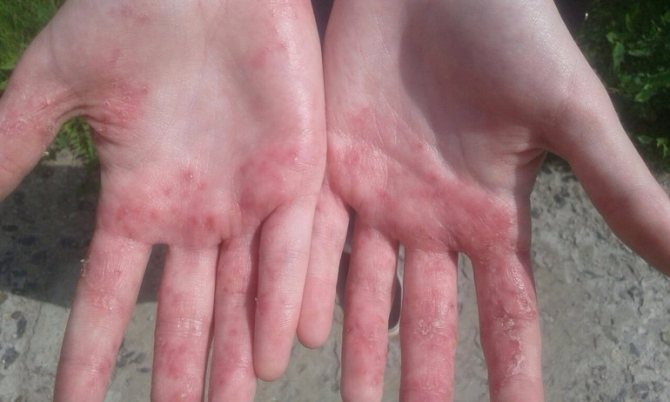
Glucocorticosteroids are represented by Dexamethasone and Prednisolone. Also included in this category is Karizon, which is considered the most powerful drug. It is advisable to use it if other drugs have not coped with the task. Antibiotics are used when purulent formations have formed on the surface of the skin. Most often these are drugs of the penicillin group, such as Doxycycline, Ampicillin. It can also be fluoroquinolones, for example, Ciprofloxacin.
Antihistamines are aimed at reducing the severity of allergic manifestations. These include Zyrtec, Erius and Suprastin. To improve gastrointestinal function, pancreatic support products such as Pancreazyme are used. Laxatives, for example, Duphalac and Senade, can also be added to the course of treatment. Enterosorbents allow you to remove any toxins and waste, as well as toxic compounds that can cause worsening symptoms. These include activated carbon, Enterosgel, Polysorb.
It is advisable to use diuretics in the presence of swelling and edema. The classic drugs in this group are Furosemide and Hypothiazide. The liver needs so-called hepatoprotectors. This is Essentiale forte N, Gepabene.
Rash on a child’s palms and feet – causes and treatment
A rash on the palms is a sign of many skin problems. This is mainly contact dermatitis or the result of chemical or toxic exposure to the skin. However, there are other more serious causes of rash on the palms.
A rash on the palms and feet of a child or adult can appear as a result of bacteria or viruses, an allergic reaction to certain foods and medications, or be caused by calluses.
Some diseases can also cause rashes on the palms and soles of the feet.
A person is constantly in contact with the environment, and most often this is through the hands. Therefore, it is not surprising that many diseases begin with the hands.
What kind of rash is there?
Rashes on the palms and soles of children can look different:
- in some cases, bubbles appear on the palms, containing liquid inside;
- if there is pus in the rash, they are called pustules;
- when the rashes are rough and stand out against the background of the skin, then blisters are diagnosed;
- when nodular elements are present inside, they are called papules;
- small rashes on the skin are called spots;
- in case of deep damage to the skin and discharge from it, erosion or skin ulcer is diagnosed.
View gallery
When a rash appears in a child, only a doctor can determine its type and prescribe the correct therapy.
Dyshidrosis
When a child develops a rash on the feet and palms, which manifests itself in the form of specific blisters filled with fluid, this may be a signal that dyshidrosis has developed. This is an infectious disease that affects the skin of the feet and hands.
Pediatricians advise monitoring the child’s condition especially closely in the spring and summer. In the hot season, relapses of the disease occur much more often and are associated with blockage of the sebaceous glands. Excessive sweating can cause dyshidrosis in a baby.
Experts identify several factors influencing the development of pathology:
- excessive sweating;
- frequent exciting situations, stress;
- fungal diseases of the dermis;
- heredity;
- diseases of the endocrine system;
- gastrointestinal pathologies;
- allergy.
According to medical statistics, a child susceptible to atopic dermatitis and diathesis is more likely to suffer dyshidrosis.
Dr. Komarovsky believes that the cause of the development of the disease is an allergic reaction of the digestive system, so it is necessary to introduce a new product into the children's diet with caution. If the child is bottle-fed, it is worth replacing the milk formula with another one with a lower concentration.
It is necessary to know the main symptoms of the pathology in order to recognize the disease in time and take measures to eliminate it.
- Dyshidrosis manifests itself in the form of a rash; it most often affects the palms, inner surfaces of the fingers on the upper and lower extremities, and feet.
- At the initial stage, the child notices an uncomfortable tingling sensation in the area of the palms and feet. This leads to the baby starting to scratch the affected skin, resulting in a rash. It begins to cause itching and burning.
- Redness and specific balls and blisters appear on the dermis, which itch and fill with fluid.
- The bubbles are small in size and reach only a few millimeters. They have a transparent tint, but the skin around them becomes red due to constant scratching.
- Over the course of a week, a maximum of 10 days, the rash on the palms and feet goes away. They may open on their own or dry out. In this case, the healing process is accompanied by unpleasant sensations: swelling occurs, erosions appear in place of former blisters, and the dermis becomes painful.
- Finally, the skin begins to peel off. When using special means, the disease is eliminated from this moment in a few days.
Parents should remember that true dyshidrosis is distinguished by the absence of new blisters. After self-opening of the rash, no new manifestations should appear. The baby may develop dry dyshidrosis, which is characterized by the absence of the stage of bubbles with liquid, and the peeling stage immediately begins.
Treatment of pathology is not difficult if you consult a specialist in time.
Pediatricians often prescribe a specific therapeutic regimen consisting of antihistamine medications: Suprastin, Fenistil, Diazolin.
Sorbent drugs (Activated carbon, Smecta, Enterosgel, Enterosorb) and sedatives that can be used in childhood are included: for example, Valerian.
Sometimes the doctor prescribes additional medications or vitamin complexes for calcium levels.
For external use, antimicrobial drugs with a drying effect are prescribed: Brilliant Green solution, Fukortsin. Also, products that can quickly dry out rashes include: Sudocrem, Furacilin solution, zinc ointment.
A prerequisite is the use of corticosteroid medications: Dermovate, Sinaflan, Lorinden, Flucinar.
It is not recommended to use these drugs directly; a small amount of ointment should be added to baby cream and applied in moderation to the skin.
Symptoms of erythema
Most often, allergic manifestations are accompanied by the following symptoms:
Source: https://xn--80ahsaqcbqq.xn--p1ai/kozha-simptomy/krapivnica-na-ladonyah-u-rebenka.html
Prevention measures
To prevent relapses - the return of the rash after treatment - it is necessary to follow preventive measures. It is important to prevent excessive sweating, dry hands, and eliminate the negative effects of toxic substances. To do this, when contacting cold, hot water, cleaning agents, detergents, it is recommended to use latex gloves.
Interesting! Latex is a highly allergenic material, so allergies are often noticed due to the use of rubber gloves. To prevent an allergic reaction, it is necessary to wear cotton gloves under rubber products.
To avoid irritation, you should thoroughly rinse off the soap after washing your hands, and wash only with warm water. Hand care is mandatory: the use of moisturizing and regenerating creams has a positive effect on the restoration of the skin on the palms. If the skin is clean and healthy, pathogenic microorganisms will not be able to penetrate, therefore, a rash will not appear.
Article on the topic: Facial allergies: photos, symptoms and treatment in [y] year
Rash on baby's hands and feet
Children's skin is so sensitive that even a slight change in normal care can cause rashes. But if a rash appears on the palms and soles of a child, then most likely he is developing a serious illness. Parents must understand the cause of skin problems and begin timely treatment.
Types of rash
In a child, a rash on the feet and palms is classified according to the secretion contained in the blisters or its absence:
- Spots - formed on the skin in single or mass quantities. Color – pale pink.
- Papules - nodular formations appear in the middle layers of the epidermis.
- Pustules - a purulent process in the dermis leads to the formation of large blisters.
- Blisters - the rash contains a clear and liquid secretion.
- Blisters are noticeable round subcutaneous blisters with a rough surface.
- Erosion - damage appears on the surface of the epithelium, leading to the release of ichor.
If a child has a rash on the feet and palms of the hands, accompanied by fever, sore throat and other suspicious symptoms, it is necessary to contact a pediatrician.
Causes of rashes
A rash on the palms of a child is a natural reaction of the body to the consequences of insufficient hygiene. But the causes of skin spots can be much more serious.
Infectious diseases
The incubation period of many infectious diseases is quite long. After contact with a sick person, there is time to prepare and carefully monitor the condition of the skin.
Infectious diseases that provoke changes in the structure of the epidermis:
- Chickenpox - itchy blisters with clear liquid are localized on the head, gradually covering all parts of the body, including the feet and palms. In mild cases, body temperature rises slightly. In severe cases of the disease, chills, nausea, and enlarged lymph nodes appear.
- Rubella - a red rash on the palms of a child occurs after the rash on the face. It can cover the entire body. During rubella, the baby may complain of pain in the joints and muscles, and he will develop photophobia.
- Measles - large red spots cover the entire body, over time, single copies merge into one. Before the appearance of rashes in the form of red dots, symptoms of a common ARVI are observed, later conjunctivitis develops.
- Scarlet fever - a small rash covers the neck and face, descending further down the body. Before its appearance, streptococcal sore throat develops. The baby feels weak and nauseous.
- Meningitis - the toxin of meningococcus paralyzes blood vessels, this leads to the formation of local hemorrhages on the skin. The baby develops a rash, body temperature rises, and a severe headache.
All of these diseases require medical supervision and placement of the small patient in the infectious diseases department of the hospital.
Parasitic infestation
There are times when parents are confused and do not understand the reasons for the appearance of spots in their child. They ask the pediatrician what it could be and how to eliminate skin problems. And it turns out that the rashes are the result of helminths multiplying in the body.
They are parasitic microorganisms that produce toxins that the immune system tries to fight. As a result of the production of protective cells of the epidermis, an allergic rash appears, which itches and inflames nearby tissues.
The presence of parasites is manifested by symptoms:
Sensitive children's skin is a favorable environment for the activity of fungal bacteria. Their active reproduction on the skin leads to skin rashes - pimples on the feet and palms turn into erosion and peel off.
Help a child
To confirm the diagnosis, the pediatrician will prescribe blood and urine tests, scrapings for microflora and tests for allergens. Depending on the result, effective therapy is prescribed, aimed at relieving symptoms and combating a specific disease. But before a diagnosis is made, parents should help the child get rid of discomfort.
To do this, you should take measures:
- If the problem is not accompanied by any additional symptoms, then the inflamed areas can be lubricated with a children's itching reliever - Advantan, Lokoid.
- For newborns, you can pour a decoction of string or chamomile into the bath.
- If the child is allergic, they are given an antihistamine for 5 days - Suprastin, Tavegil, Erius. Its dosage depends on the age and weight of the baby.
- Eliminate contact with the allergic substance. If this is a food product, then it is prohibited to give it to a child. If possible, exclude animals from the house and carry out general cleaning to get rid of dust.
- Rashes caused by a bacterial infection are treated with antibiotic medications.
If the baby’s feet and palms become covered in spots, and his body temperature rises to critical levels, then parents should urgently call for medical help.
Preventive measures
Having looked at the photos with explanations on the Internet pages showing the types of skin rashes, the mother should do everything to prevent her child from having such skin problems.
For this, preventive measures are necessary:
- timely vaccination;
- children's clothing - natural and high quality;
- If you are prone to allergies, do not have pets;
- regular wet cleaning of the house;
- long walks in the fresh air;
- strengthening the immune system;
- taking vitamin complexes;
- compliance with hygiene rules.
Diagnostics
A specialist will be able to identify urticaria the first time a patient seeks help. However, this is not enough to prescribe adequate therapy. It is important to understand what exactly provokes the development of the disease, how often blisters appear, and what substances act as allergens.
A qualified physician should order a comprehensive examination. Often, in order to identify the exact causes of urticaria on the hands, it is necessary to undergo examination by several specialists at once.
In this case, laboratory diagnostic methods such as:
- general and biochemical blood test;
- analysis to detect antibodies to infections (HIV, syphilis, hepatitis);
- studies excluding autoimmune diseases;
- urine and stool analysis.
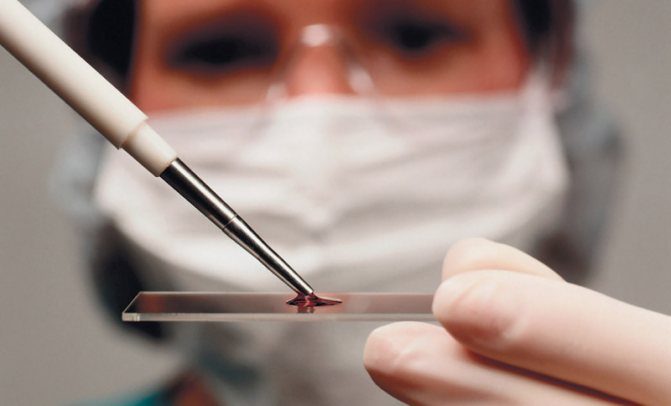
An accurate diagnosis can be made through laboratory tests.
Allergy tests are required. A potential allergen is applied to a small area of skin and the body's reaction is observed for 10 minutes. If you suspect cold urticaria, place a piece of ice on your hands. If a negative reaction of the body develops in the sun, place your hands under an ultraviolet lamp.
Additionally, the patient must consult the following specialists: endocrinologist, gynecologist (for women), dentist, otolaryngologist, gastroenterologist.
Viral infection
A rash on the palms, feet and fever may occur for various reasons. Treatment must be selected in accordance with what factors provoked the disorder. Often this problem is associated with the occurrence of infectious diseases in the body. In addition to rashes and fever, the following signs are observed:
- chills;
- a sore throat;
- loss of appetite;
- abdominal pain;
- cough.
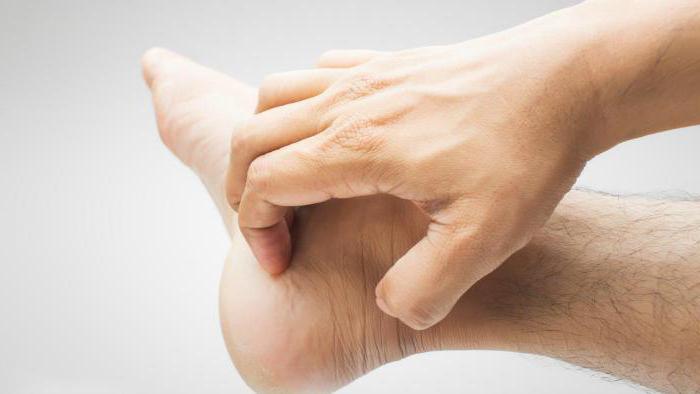
All these signs may be characteristic of various diseases. A similar condition is often observed with the following ailments:
- measles;
- chickenpox;
- meningococcus;
- scarlet fever.
Each of these infectious diseases has its own characteristics and manifestations. Therefore, it is very important to recognize their course in time so as not to aggravate the pathological process. Meningococcal infection is especially dangerous, since its complications can lead to the death of the patient.
